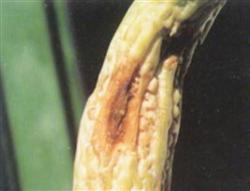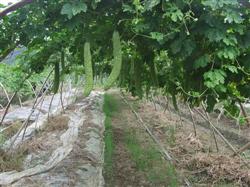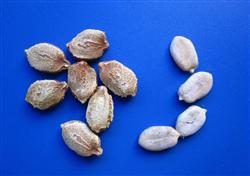How to plant balsam pear with high quality and high yield?

Balsam pear, also known as "cold gourd", is a temperature-loving vegetable with a suitable growth temperature of 20 ℃ 25 min. In recent years, through variety breeding, it can be planted in spring, summer and autumn, and has gradually become the main melon variety. In order to obtain high quality and high yield in planting balsam pear, we must pay attention to the following points: first, select improved varieties. Select the improved varieties that are resistant to fertilizer, heat, storage and transportation, large melon type, thick melon meat, high yield and good quality, such as Zaofeng 3, Cuilu 1, Suiyou, Emerald, Da Ding balsam pear, Jiangmen balsam pear, slippery body balsam pear, Xiafeng 2, Qingyu balsam pear, Xinlu No. 2 long body oil gourd and so on. Second, accelerate budding and raising seedlings. The seed coat of balsam pear is hard, soaking seeds to promote germination before sowing, in order to facilitate seedling emergence. Generally, spring planting should be sown from the end of January to April, summer planting in May-June, and autumn planting in July-August. Put the seeds in warm water before sowing, wash off the colloid with a fine grinding wheel, wrap them with clean gauze, soak the seeds in clean water for 12 hours, pick up the seeds, wrap them with gauze or wet paper, wrap them with film to heat preservation and accelerate germination, keep the temperature at 28 ℃, moist and germinate, sprout in 4 days or so, and the bud can be sown in 1 cm long. Use nutrition cup to raise seedlings, prepare mixed nutrient soil with high-quality rotten farm manure, calcium superphosphate, potassium chloride and vegetable garden mud. After retting for 25 days, sow the germinated seeds in the nutrition cup, cover about 3 cm thin soil layer, put into the seedling bed, then build a shed with bamboo bow, 45m 50cm high, cover cold proof seedlings with nylon film, wait for melon seedlings to grow out 5 colors and 6 leaves, then can be transplanted to the field. Third, land selection and land preparation. Balsam pear is not strict with soil, but it is better to use clay with rich, moist, deep soil layer and convenient drainage and irrigation. Should choose the land that has not planted melons for more than two years and has strong water power to preserve fertilizer. The general width of the bed is 1.5 meters and the height of the bed is 30 meters and 40 cm. Fourth, apply sufficient base fertilizer. Balsam pear has a long growth period, high yield and large amount of fertilizer. The base manure was applied to 1500m / mu of rotten farm manure, 80kg of superphosphate, 25kg of potash fertilizer and 12kg of urea, and sprinkled evenly in the ditch. Fifth, reasonable close planting. Balsam pear can be planted in single row and double plant, with a distance of 60ml / 70cm; a single plant in a single row with a distance of 28cm / 30cm; a single plant in a double row with a spacing of 40cm / 50cm and a row spacing of 40m / 50cm. After transplantation, thin water was poured into the root. 6. Water and fertilizer management. Balsam pear likes to be wet, but is not resistant to waterlogging. Sufficient water supply is needed in seedling stage and flowering and fruiting stage. Border surface should be kept moist. Waterlogging should be eliminated in time after rainstorm to prevent rotting roots. Balsam pear should be fertilized in time in addition to applying sufficient base fertilizer when planting. Thin application of water and fertilizer should be applied twice at seedling stage to ensure early growth and rapid growth of melon seedlings. Once every 7 days before the first appearance of female flowers and the first harvest of melons, and after each harvest, digging shallow ditches on both sides of the border, applying 40 50kg compound fertilizer or 10 kg urea plus 30 kg phosphate fertilizer plus 15 kg potash fertilizer per mu, and then covering soil, or 500 kg per mu of mature manure plus 4 kg urea mixed with 4 kg urea to prolong the harvest period. Seventh, pruning and pulling vines. When the balsam pear grows and pulls out the silk, it is necessary to insert the herringbone hedge scaffolding to draw the vine on the shelf to avoid the vines and leaves winding each other and the top of the frame to cross and tie tightly. Balsam pear branching force is strong, the early introduction of vines should be carried out frequently, in the sunny afternoon, in order to prevent vines. After the fruit of the main vine is harvested, it is transferred to the side branches to bear melons. Therefore, after introducing the vine on the shelf, the side branches of the stem of the main vine below 40Mel 50 cm should be removed, and the over-dense old leaves and the upper thin and weak side vines should be removed to make the field ventilated and transparent, reduce diseases and improve fruit setting rate. 8. harvest at the right time. Balsam pear should be harvested in time to ensure quality and increase late fruit. When the fruit grows to a certain length, the shoulder of the fruit is enlarged, the tumor groove becomes shallow, the top tip of the melon is big and round, the fruit is shiny and the fruit color is green, it should be harvested and listed in time. Prevention and control of diseases and insect pests. The main diseases of balsam pear are seedling blight, quenching, anthracnose, powdery mildew and Fusarium wilt. Quenching disease and blight can be sprayed with 200ppm agricultural streptomycin, 25% chlorothalonil, or 50% carbendazim. Anthracnose and powdery mildew can be sprayed with 50% thiophanate or Dysen zinc 500 times, or 75% chlorothalonil or Ruiduo 600-700 times, respectively; diseased leaves and melons should be removed, and then 50% anthrax 300-400 times, or 20% Fumei 1500 times, 2000 times should be sprayed. Fusarium wilt can be sprayed or drenched with 1000-fold solution of 70% dioxone 800m; 30 days after planting, 50% topiramate 600-fold solution is used to drench the root for half a liter, or 10% Shuangxiaoling 200-300 times solution is used to drench the root, which has a certain control effect. The main pests of balsam pear are aphids, red spiders, Huangshou melon, black melon, melon fruit fly, etc., which can be sprayed with 500,800 times of dichlorvos or trichlorfon, 1000 times of triclofenac or 2.5% cypermethrin and 3000-4000 times of fenvalerate.
- Prev

It is not advisable for balsam pear to top fertilize with water.
At present, balsam pear vegetable farmers generally use topdressing with water, although this is very convenient, and fertilizer can be evenly applied to the soil, but balsam pear topdressing in this way is not desirable. The reason is that the number of balsam pear plants per mu is less, only 200 plants per mu, only 3 plants per row, if taken with.
- Next

A little trick to sprout balsam pear
First, prepare about 55 ℃ of warm water, put it in a boiled water bottle or other container that can keep warm; put the balsam pear seeds in a gauze bag, wash them with clean water, wipe the seeds gently when washing, remove the impermeable substances on the surface, soak the washed seeds in prepared warm water, keep them warm for 10 minutes, and constantly stir, then add.
Related
- Where is it suitable to grow horseradish in China? it is expected to see the middle altitude horseradish in Alishan.
- How to prevent tomato virus disease reasonably? (Control methods included)
- Many people like to plant towel gourd on the balcony. What are the main points of this method and management?
- What crops can chili peppers be mixed with?
- Fertilization techniques and matters needing attention in Tomato
- What are the grafting techniques for peach seedlings in spring?
- Harm and control methods of root swelling disease of Chinese cabbage
- What are the pests of sweet potatoes? How to prevent and cure it?
- Symptoms, causes and Control methods of navel Rot in Tomato
- The cause of "Cucumber rotten bibcock" in Farmers' planting Cucumber and its Control Plan

